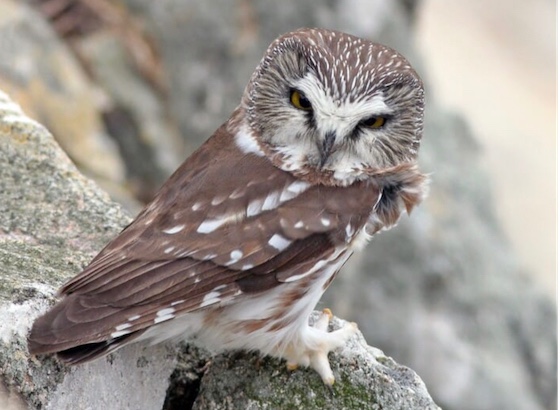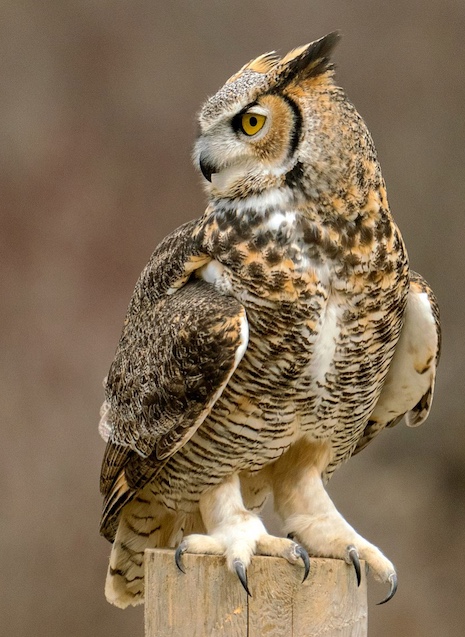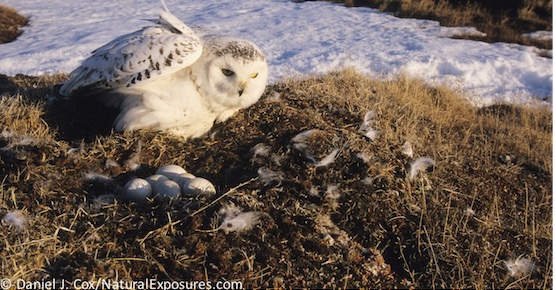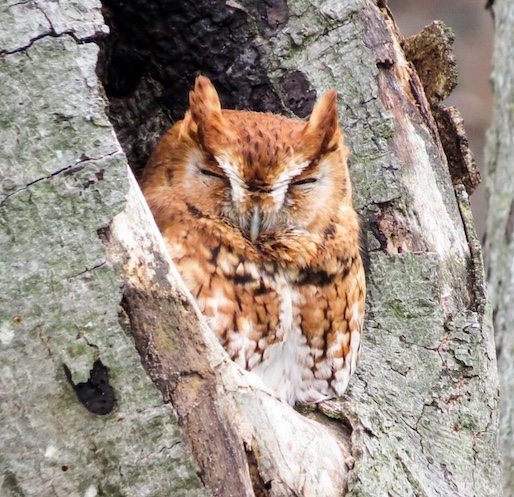What is it about Owls?

By Linda Martinson
For almost 40 years we lived in a wonderful old neighborhood in Atlanta. It was a small, hilly, self-contained neighborhood with twisty roads, small houses, big trees, overgrown alleys, sidewalks, and pocket parks near the venerable Bobby Jones golf course. And it had critters: squirrels and rabbits of course, foxes, badgers, skunks, coyotes, and a black bear once spotted there. One early morning on my way to meet my running chums, I saw two coyotes cavorting on the golf course. And occasionally I saw owls, usually great horned owls that are often active at dusk and dawn.
There is something about the owls…they seem to have a bead on you, staring directly at you without blinking. And their flight is eerily quiet even though their wings flap dramatically as they launch themselves from a limb or some other perch. And their hoots are compelling, too—they certainly sound different from other birds! Something about owls feels different — they seem remote, in charge, strong, subtle, secretive…almost sneaky, and (yes) wise.
Like all birds, owls have a long lineage of sixty-seven million years ago starting not long (evolutionarily speaking) after the extinction of dinosaurs. Birds are often considered the only living descendants of dinosaurs, and their evolution happened fast! One estimation is that more than 10,000 bird species evolved in only a few million years after dinosaurs became extinct. Owls are among only a few species of birds that are nocturnal and are the most common night birds in North America. For all these past millions of years, most owls have been flying, hunting, hatching eggs and raising chicks in the dark.
Owls belong to the phylogenetic class Aves with all other birds and to the taxonomic order Strigiformes with estimations of 134 to 200+ species of owls found in all parts of the world in diverse habitats. There are two families of owls: Tytonidae (mostly barn owls, the older family with heart-shaped faces, 17 species) and Strigidae (typical or “true” owls with round faces). In most raptor species, including owls, females are often larger than males. Great horned owl females, for example, are about 25% bigger than the males. In all species of owls however, males and female owls look alike. Owl species have distinct calls ranging from soft hoots to screeches and even more. They are adaptive and environmentally successful wherever they live except in areas where their habitat is being destroyed.

Great horned owl…note the talons
Wikipedia
Owls are powerful raptors, usually nocturnal with big, fixed, forward- facing eyes. They don’t have eyeballs so they can’t roll their eyes. Instead they have eye tubes that are elongated and held in place by bony skull structures in the skull called sclerotic rings. Essentially, owls gave up eye movement for keen visual acuity and superior night vision. They also have three eyelids: one for blinking; one for sleeping; and one for keeping their eyes and eye tubes clean.
Owls also have extremely sensitive ears; it is estimated that some owls can hear up to 10 times better than humans. Their faces are elliptical like satellite dishes, and their ears are offset allowing them to pinpoint sounds. They have large heads; hooked beaks; flexible necks (they can turn their heads 270 degrees); long bodies with soft thick feathers, and their flight is silent. Many owl species also have sensitive feathered legs and feet. Their talons are very flexible, powerful, locking, and sharp and the bones in their feet are shorter and stronger than those of other birds. Picture an owl silently swooping in to capture its prey with flexible and powerful talons like battering rams! They are certainly impressive birds and predators.
Owls are carnivorous usually eating rodents and other small mammals, reptiles, amphibians, birds, eggs, and fish. They hunt mainly at night in forests, wooded areas, and deserted places like cemeteries and run-down farms and gulp down what they catch whole because, like most birds, they cannot chew their food. The owl’s digestive tract compresses the parts of the prey it can’t digest, such as fur and bones, into a compact pellet that the owl coughs up.
Barn owls frequently live in (what else) barns and in other deserted buildings but in general, most species of owls don’t bother to build nests. Instead they simply take over the abandoned nests of other birds or they roost in hollow trees; in rock face crevices; and inside dense evergreen trees in cold weather. They just may nest on the ground. And sometimes they just take over squirrel nests by slamming into the side of its nest essentially knocking the squirrels out. If owls do build a nest, it’s usually a slipshod job.
Mating time for most owls is in late winter, and males seek their mates by calling for them. Owl calls vary by species, but generally large owls hoot and small owls toot. Females respond only to the calls of the males of her species, and she listens for calls that interest her and answers them. A male will respond by showing off. He preens and fluffs out his feathers and often brings gifts of food. Many male owls perform “sky dances”. At the end of the male’s performance, he dives down past the female to the ground and if the female follows him, they are a couple. Mating owls spend a great deal of time together preening/grooming each other.

National Geographic
Owls are fearsome hunters and devoted partners. The females usually select the location for whatever they decide is their nest, and it becomes home and the area around it is commandeered as home territory. Their nest/nesting area is home for the roosting pair for several months, and the two mates defend it fiercely especially after their chicks are hatched.

Owls gauge how much food is available in a given year and may not lay any eggs but usually, depending on the species and the local food supply, female owls lay between one to fourteen roundish white eggs. Eggs are often not laid all at once but rather there may be several eggs laid up to four or more days apart. This is called asynchronous hatching and results in chicks of different ages in the same nest. It is common among owls and other raptors. Females incubate the eggs by pulling feathers off their chests and pressing their warm bare belly against the eggs. She lies in a still, prone brooding position warming the eggs for most of the incubation period.
Male owls bring food to the female owl during brooding and for some time after the chicks are born. Chicks hatch 3 to 5 weeks after the eggs are laid with the length of time varying by species. When the owlets hatch, they are covered with downy, white feathers; their eyes are closed; and they are helpless for a few weeks. During that time, the female continues to brood, keeping the chicks warm, and feeds them small pieces of food that the male continues to bring her.
After a few weeks, the chicks open their eyes; darker feathers replace the downy ones; and they can be left alone in the nest for longer periods of time. Because the eggs hatch at different times in the order in which they were laid, the first owlets in a nest could be several days older than the last ones to hatch. Owl chicks grow quickly and within a few weeks they are tearing apart the prey the adult owls bring.
As chicks get bigger, they begin to explore outside the nest. They often hang around begging loudly for food even after they start flying at 7-8 weeks old (teen-age phase?). The adult owls are usually attentive to the fledgling owls until the young owls are close to full grown, but then they are on their own. Owls can live up to 25 years.

allaboutbirds.org
There are five species of owls that regularly nest in the Blue Ridge Mountains regions: great horned owls (Bubo virginianus); eastern screech owl (Megascops asio); northern barred owl (Strix varia); barn owl (Tyto alba); and the least common and smallest, northern saw-whet owl (Aegolius acadicus). Snowy owls are spotted occasionally, but they don’t regularly nest in our region.
The great horned owl is the quintessential owl…handsome and formidable. This is a big owl, the second largest owl in North America after its close cousin the snowy owl, and among the fastest owls in the world. Adult great horned owls range from 17-24” long and weigh about 3 pounds. Their wing span is up to 5 feet, and they can fly up to 40 miles an hour in totally, almost eerie, quiet flight. Distinctive features of this handsome owl are its golden eyes; the tufts on each side of its head; and its deep hooting call. The tufts are just feathers, not horns or ears. The great horned owl is a powerful predator hunting not only small prey like mice, frogs, and scorpions, but also birds and mammals larger than itself.
The great horned owl is quite common not only in North Carolina, but throughout both North and South America from the Arctic Circle to the tip of South America. As one of the most common owls in North America, great horned owls are found in cities, farms, suburban and city backyards, deserts, wetlands, forests and almost any other semi-open habitat in its wide range. There are about a dozen sub-species of the great horned owl distinguished by variations in color, geographic region and preferred habitat. They are seen fairly frequently in North Carolina forests and neighborhoods both because it is a year round resident and because it is out and about more than other owls.
Watch for great horned owls late at night and early in the morning in the tops of trees. It is exciting to see them sitting and waiting for signs of prey below, and then blasting down silently flapping their big wings to swoop up an unsuspecting meal.

Great horned owl (Bubo virginianus)
Wikipedia image by Greg Hume

Darren Clark
allaboutbirds.org
Barn owls are also common birds and almost always strictly nocturnal. They are medium sized owls, about the size of a big crow, with dark eyes, rather long, rounded wings, lanky legs, short tails and a smooth heart-shaped face without ear tufts. Barn Owls have white faces, front, and underwings with a mix of buff and gray on their backs and upper wings and sometimes on their chests. When they are seen hunting at night, they usually appear to be all white and with their quiet flight and their dark eyes, rather eerie. Unlike the hoots of many other owls, barn owls have quick, raspy calls.
They usually roost in barns and deserted buildings or in dense tree cover. At night, they fly back and forth over fields mainly searching for mice by sound. Except in northern climes, barn owls have a worldwide distribution. They can be found in every part of the US except the northern states and in Central and South America. Despite their almost worldwide distribution, barn owls are declining in many parts of their range because of habitat loss.
You won’t forget it if you hear the barred owl’s call: “Who cooks for you? Who cooks for you-all?” He repeats it again and again, with feeling. Listen to his call at allaboutbirds.org. And during courtship, mated pairs carry on with a rollicking duet of hoots, cackles, gurgles and caws. They are handsome owls with deep black eyes and striking marking of mottled brown and white vertical and horizontal bars, hence their name.
Barred owls live mostly in the eastern United States and southeast Canada although some have moved to the Pacific northwest. There they are often considered an invasive species because they are crowding out spotted owls that are already threatened by habitat loss. Barred owls are typically forest birds, and they prefer large, dead trees for nest sites. Like great horned owls, barred owls can be aggressive. They are smaller than a great horned owl and larger than a barn owl, about 17” to 20” tall and weighing about one pound. Barred Owls are stocky owls with rounded heads; no ear tufts; and medium length, rounded tails.

W Scott Young image
allaboutbirds.org
The screech owl is another one of the familiar owls of the Southern Appalachians. There are 23 species of the screech owl (Megascops casio) and Appalachians and, like great horned owls and barred owls, they are quite common in the areas around ours at Richland Ridge. Roosting screech owls are supremely camouflaged birds. The color pattern of eastern screech owl in the Southern Appalachian Mountains is the red morph. There is also a grey morph eastern screech owl that is more common. The red morph is more common in the Northern Appalachians, and there are also intermediates varieties, too. Their range is generally the eastern half of the US extending just past the Dakotas.

Adam Beteul image
allaboutbirds.org
Screech owls are compact, small, and agile, 7 to 10 inches tall with a wingspan of 18 to 24 inches. and their prey is also small, eg., insects and small reptiles, mammals and birds. Because larger raptors might abscond with their catch, screech owls generally take their prey back to a hidden niche and tear it apart and eat it there. Like the great horned owl, screech owls have feather tufts on their heads and yellow eyes. They don’t exactly screech or scream; their cry is more of a piercing call often almost a trill. They also have a mating “song” which the mating pair sings almost as a duet. However, different species of screech owls look very similar, but have vastly different calls even in adjacent regions.
The fifth owl species commonly found in the Southern Appalachians is the northern saw-whet owl. It is a small owl that breeds mostly in the spruce-fir forests along the crests of the Appalachian ridges. Simon Thompson, a local ornithologist who organizes bird watching and adventure tours (birdadventures.com) describes that the northern saw-whet owl was thought to nest only as far south in West Virginia until two university students heard the owl calling at Clingman’s Dome in the Great Smoky Mountains in June 1941.

Cameron Rutt photo
allaboutbirds.org
The northern saw-whet is a tiny owl with and oversized head and a catlike face. They have bright yellow eyes and are described as “practically bursting with attitude”, i.e., they are quite feisty for their size. Saw-whets are one of the world’s smallest owls: 7 to 8 inches long, weighing only 2.3 to 5.3 ounces with a wingspan of 16.5 to 19 inches. The northern saw-whet owl is common across northern North America and has spread to evergreen mountain forests across the U.S. especially in the winter. They are silent fierce hunters of small mammals, usually mice. Their breeding patterns are typical of most owls: rather careless nest selection but attentive care of their chicks.
Saw-whets are almost strictly nocturnal and therefore seldom seen although some daytime hikers have reported seeing them roosting at eye level in evergreen trees. The most distinguishing characteristic of both juvenile and adult saw-whet owls is the white “V” between their eyes. There is some confusion about its cry. Apparently, the “saw-whet” part of its common name was originally bestowed on the breed because its call was similar to the sound of a saw being sharpened on a whetstone, but that’s controversial.
Most often saw-whet owls are described as having a persistent but pleasantly high-pitched too-too-too call, and it is a fairly common night sound in the evergreen mountain forests in the Southern Appalachians from January through May. Why is the saw-whet call a common sound only from January through May? It is because of another controversial characteristic of northern saw-whets: they seem to migrate but not much is known about their migration patterns. It seems that many individual saw-whets migrate south or to lower elevations while some remain in one location all year but are much more quiet after mating season. And about once every four years, groups of northern saw-whet owls irrupt, i.e., they migrate south that year in abnormally larger numbers than usual. It is still a mystery, but they all leave at about the same time using several known migration routes across the continent and crossing large expanses of water. This sounds almost like a mast year of bird migration!
We are fortunate in the Southern Appalachian area to have several distinctive and exciting resident owls and bird experts. If you are intrigued and want to learn more about owls, watch for classes offered by the NC Arboretum and check out Ventures Birding Tours — they offer some owl tours. Also, Cornell Lab offers an online class about owls. Take a few minutes to check out the introduction to their online Bird Academy class for excellent photos and videos of owls: https://academy.allaboutbirds.org/free-preview-the-wonderful-world-of-owls/. Finally, there have been numerous books written about owls…start reading them and you, too, may join the large numbers of people smitten with owls.
References:
“Barred Owl” Melissa Mayntx The Spruce 5/10/19
Blue Ridge Bird Observatory “Southern Appalachian Raptor Research”
“Characteristics and Behavior of Owls” Candace Berkeley carolina.com 4/2019
“Owls in Western North Carolina” T.M. Hughes. Owlcation, November 7, 2014
The Owl Pages
Owl Research Institute
Venture Birding Tours Simon Thompson







96 comments